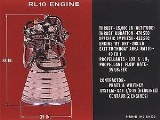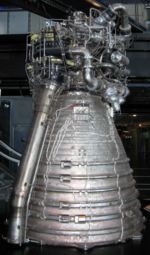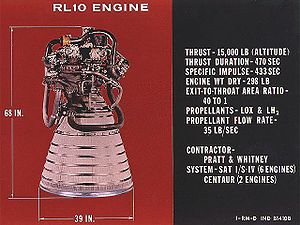
Cryogenic Rocket Engine
Encyclopedia


Rocket engine
A rocket engine, or simply "rocket", is a jet engineRocket Propulsion Elements; 7th edition- chapter 1 that uses only propellant mass for forming its high speed propulsive jet. Rocket engines are reaction engines and obtain thrust in accordance with Newton's third law...
that uses a cryogenic fuel
Cryogenic fuel
Cryogenic fuels are fuels that require storage at extremely low temperatures in order to maintain them in a liquid state. Cryogenic fuels most often constitute liquefied gases such as liquid hydrogen....
or oxidizer, that is, its fuel or oxidizer (or both) are gases liquefied and stored at very low temperatures. Notably, these engines were one of the main factors of the ultimate success in reaching the Moon by the Saturn V
Saturn V
The Saturn V was an American human-rated expendable rocket used by NASA's Apollo and Skylab programs from 1967 until 1973. A multistage liquid-fueled launch vehicle, NASA launched 13 Saturn Vs from the Kennedy Space Center, Florida with no loss of crew or payload...
rocket.
During World War II
World War II
World War II, or the Second World War , was a global conflict lasting from 1939 to 1945, involving most of the world's nations—including all of the great powers—eventually forming two opposing military alliances: the Allies and the Axis...
, when powerful rocket engines were first considered by the German, American and Soviet engineers independently, all discovered that rocket engines need high mass flow rate
Mass flow rate
Mass flow rate is the mass of substance which passes through a given surface per unit time. Its unit is mass divided by time, so kilogram per second in SI units, and slug per second or pound per second in US customary units...
of both oxidizer and fuel to generate a sufficient thrust. At that time oxygen and low molecular weight hydrocarbons were used as oxidizer and fuel pair. At room temperature and pressure, both are in gaseous state. Hypothetically, if propellants had been stored as pressurized gases, the size and mass of fuel tanks themselves would severely decrease rocket efficiency. Therefore, to get the required mass flow rate, the only option was to cool the propellants down to cryogenic temperatures (below −150 °C, −238 °F), converting them to liquid
Liquid
Liquid is one of the three classical states of matter . Like a gas, a liquid is able to flow and take the shape of a container. Some liquids resist compression, while others can be compressed. Unlike a gas, a liquid does not disperse to fill every space of a container, and maintains a fairly...
form. Hence, all cryogenic rocket engines are also, by definition, either liquid-propellant rocket engines or hybrid rocket engines.
Various cryogenic fuel-oxidizer combinations have been tried, but the combination of liquid hydrogen (LH2) fuel and the liquid oxygen (LOX
Lox
Lox is salmon fillet that has been cured. In its most popular form, it is thinly sliced—less than in thickness—and, typically, served on a bagel, often with cream cheese, onion, tomato, cucumber and capers...
) oxidizer is one of the most widely used. Both components are easily and cheaply available, and when burned have one of the highest entropy
Entropy
Entropy is a thermodynamic property that can be used to determine the energy available for useful work in a thermodynamic process, such as in energy conversion devices, engines, or machines. Such devices can only be driven by convertible energy, and have a theoretical maximum efficiency when...
releases by combustion, producing specific impulse
Specific impulse
Specific impulse is a way to describe the efficiency of rocket and jet engines. It represents the derivative of the impulse with respect to amount of propellant used, i.e., the thrust divided by the amount of propellant used per unit time. If the "amount" of propellant is given in terms of mass ,...
up to 450 s (effective exhaust velocity 4.4 km/s).
Construction
The major components of a cryogenic rocket engine are the combustion chamberCombustion chamber
A combustion chamber is the part of an engine in which fuel is burned.-Internal combustion engine:The hot gases produced by the combustion occupy a far greater volume than the original fuel, thus creating an increase in pressure within the limited volume of the chamber...
(thrust chamber), pyrotechnic igniter, fuel injector, fuel cryopump
Cryopump
A cryopump is a vacuum pump that traps gases and vapours by condensing them on a cold surface. They are only effective on some gases, depending on the freezing and boiling points of the gas relative to the cryopump's temperature...
s, oxidizer cryopumps, gas turbine
Gas turbine
A gas turbine, also called a combustion turbine, is a type of internal combustion engine. It has an upstream rotating compressor coupled to a downstream turbine, and a combustion chamber in-between....
, cryo valves, regulators, the fuel tanks, and rocket engine nozzle. In terms of feeding propellants to combustion chamber, cryogenic rocket engines (or, generally, all liquid-propellant engines) work in either an expander cycle, a gas-generator cycle
Gas-generator cycle (rocket)
The gas generator cycle is a power cycle of a bipropellant rocket engine. Some of the propellant is burned in a gas-generator and the resulting hot gas is used to power the engine's pumps. The gas is then exhausted...
, a staged combustion cycle
Staged combustion cycle (rocket)
The staged combustion cycle, also called topping cycle or pre-burner cycle, is a thermodynamic cycle of bipropellant rocket engines. Some of the propellant is burned in a pre-burner and the resulting hot gas is used to power the engine's turbines and pumps...
, or the simplest pressure-fed cycle
Pressure-fed cycle (rocket)
The pressure-fed cycle is a class of rocket engine designs. A separate gas supply, usually helium, pressurizes the propellant tanks to force fuel and oxidizer to the combustion chamber. To maintain adequate flow, the tank pressures must exceed the combustion chamber pressure.Pressure fed engines...
.
The cryopumps are always turbopump
Turbopump
A turbopump is a gas turbine that comprises basically two main components: a rotodynamic pump and a driving turbine, usually both mounted on the same shaft, or sometimes geared together...
s powered by a flow of fuel through gas turbines. Looking at this aspect, engines can be differentiated into a main flow or a bypass flow configuration. In the main flow design, all the pumped fuel is fed through the gas turbines, and in the end injected to the combustion chamber. In the bypass configuration, the fuel flow is split; the main part goes directly to the combustion chamber to generate thrust, while only a small amount of the fuel goes to the turbine.
LOX+LH2 rocket engines by country
Currently, six countries have successfully developed and deployed cryogenic rocket engines:United States
United States
The United States of America is a federal constitutional republic comprising fifty states and a federal district...
- SSMESpace Shuttle main engineThe RS-25, otherwise known as the Space Shuttle Main Engine , is a reusable liquid-fuel rocket engine built by Pratt & Whitney Rocketdyne for the Space Shuttle, running on liquid hydrogen and oxygen. Each Space Shuttle was propelled by three SSMEs mated to one powerhead...
- J-2J-2 (rocket engine)Rocketdyne's J-2 rocket engine was a major component of the Saturn V rocket used in the Apollo program to send men to the Moon. Five J-2 engines were used on the S-II second stage, and one J-2 was used on the S-IVB third stage. The S-IVB was also used as the second stage of the smaller Saturn IB...
- RL-10RL-10The RL10 was USA's first liquid hydrogen fueled rocket engine. An updated version is used in several current launch vehicles. Six RL10 engines were used in the S-IV second stage of the Saturn I rocket. One or two RL10 engines are used in the Centaur upper stages of Atlas and Titan rockets...
- RS-68
- RS-83Rs-83The RS-83 was a rocket engine design for a reusable liquid hydrogen/liquid oxygen rocket larger and more powerful than any other. The RS-83 was designed to last 100 missions, and was intended for use on the first stage of a two-stage-to-orbit reusable launch vehicle.- Development :It was developed...
Russia
Russia
Russia or , officially known as both Russia and the Russian Federation , is a country in northern Eurasia. It is a federal semi-presidential republic, comprising 83 federal subjects...
- RD-0120
- RD-0146RD-0146The RD-0146 is a Russian cryogenic rocket engine. It is said to be the Russian version of the Pratt & Whitney Rocketdyne RL10 engine. The RD-0146 engine was developed by KBKhA design bureau in Voronezh, Russia, in cooperation with the American Pratt & Whitney Rocketdyne company...
China
China
Chinese civilization may refer to:* China for more general discussion of the country.* Chinese culture* Greater China, the transnational community of ethnic Chinese.* History of China* Sinosphere, the area historically affected by Chinese culture...
- YF-50tYF-50tThe YF-50t is a Chinese cryogenic rocket engine being developed to power the upper stages of the Long March 5 family of launch vehicles. It is an indigenous development based on Chinese experience with the YF-73 and YF-75 upper stage engines. It is gimballed in two axes...
- YF-73YF-73The YF-73 is China's first successful, cryogenic, gimballed engine, using liquid hydrogen fuel and liquid oxygen oxidizer. It was developed in the early 1980s and first flight was in 1984.- Specifications :*Vacuum thrust: 44.15 kN...
- YF-75YF-75The YF-75 is China's second generation of cryogenic gimballed engine, using liquid hydrogen fuel and liquid oxygen oxidizer. Its development began in the early 1990s and its first flight was in 1994.- Specifications :*Vacuum thrust: 78.45 kN...
- YF-77YF-77The YF-77 is currently China's most powerful cryogenic rocket engine using liquid hydrogen fuel and liquid oxygen oxidizer. Engine development began in the 2000s, with testing directed by the China National Space Administration commencing in 2005...
France
France
The French Republic , The French Republic , The French Republic , (commonly known as France , is a unitary semi-presidential republic in Western Europe with several overseas territories and islands located on other continents and in the Indian, Pacific, and Atlantic oceans. Metropolitan France...
- VulcainVulcainVulcain is a family of European cryogenic first stage rocket engines for the Ariane 5.-History:The development of Vulcain, assured by a European collaboration, began in 1988 with the Ariane 5 rocket program. It first flew in 1996 powering the ill-fated flight 501 without being the cause of the...
- HM7-B
- VinciVinci (rocket engine)Vinci is a European Space Agency cryogenic rocket engine currently under development. It is designed to power the new upper stage of Ariane 5, ESC-B, and will be the first European re-ignitable cryogenic upper stage engine, raising the launcher's GTO performances to 12 t.-Overview:Vinci is an...
Japan
Japan
Japan is an island nation in East Asia. Located in the Pacific Ocean, it lies to the east of the Sea of Japan, China, North Korea, South Korea and Russia, stretching from the Sea of Okhotsk in the north to the East China Sea and Taiwan in the south...
- LE-7 / 7ALE-7The LE-7 and its succeeding upgrade model the LE-7A are staged combustion cycle LH2/LOX liquid rocket engines produced in Japan for the H-II series of launch vehicles...
- LE-5 / 5A / 5BLE-5The LE-5 liquid rocket engine and its derivative models were developed in Japan to meet the need for an upper stage propulsion system for the H-I and H-II series of launch vehicles. It is a bipropellant design, using LH2 and LOX. Primary design and production work was carried out by Mitsubishi...
India
India
India , officially the Republic of India , is a country in South Asia. It is the seventh-largest country by geographical area, the second-most populous country with over 1.2 billion people, and the most populous democracy in the world...
- CE-15CE-7.5The CE-7.5 is a cryogenic rocket engine developed by India to power the upper stage of its Geosynchronous Satellite Launch Vehicle. The engine was developed as a part of the Cryogenic Upper Stage Project . It will replace the RD-0120 currently powering the upper stage of GSLV...
- CE-20CE-20Th CE-20 is a cryogenic rocket engine being developed by India. The CE-20 engine is being developed by the Liquid Propulsion Systems Centre, a subsidiary of ISRO. It is being developed to power the upper stage of the Geosynchronous Satellite Launch Vehicle III...

